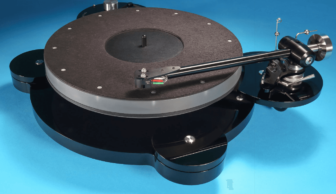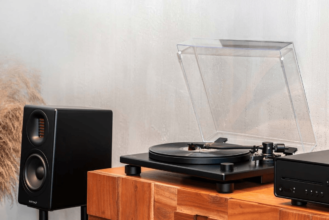Rega Naia/Aphelion 2 review
At first glance, the Naia looks similar to the familiar P10 model. But Rega’s new top turntable offers much more than cosmetic improvements: analog technology pushing the limits and a breathtakingly detailed sound.
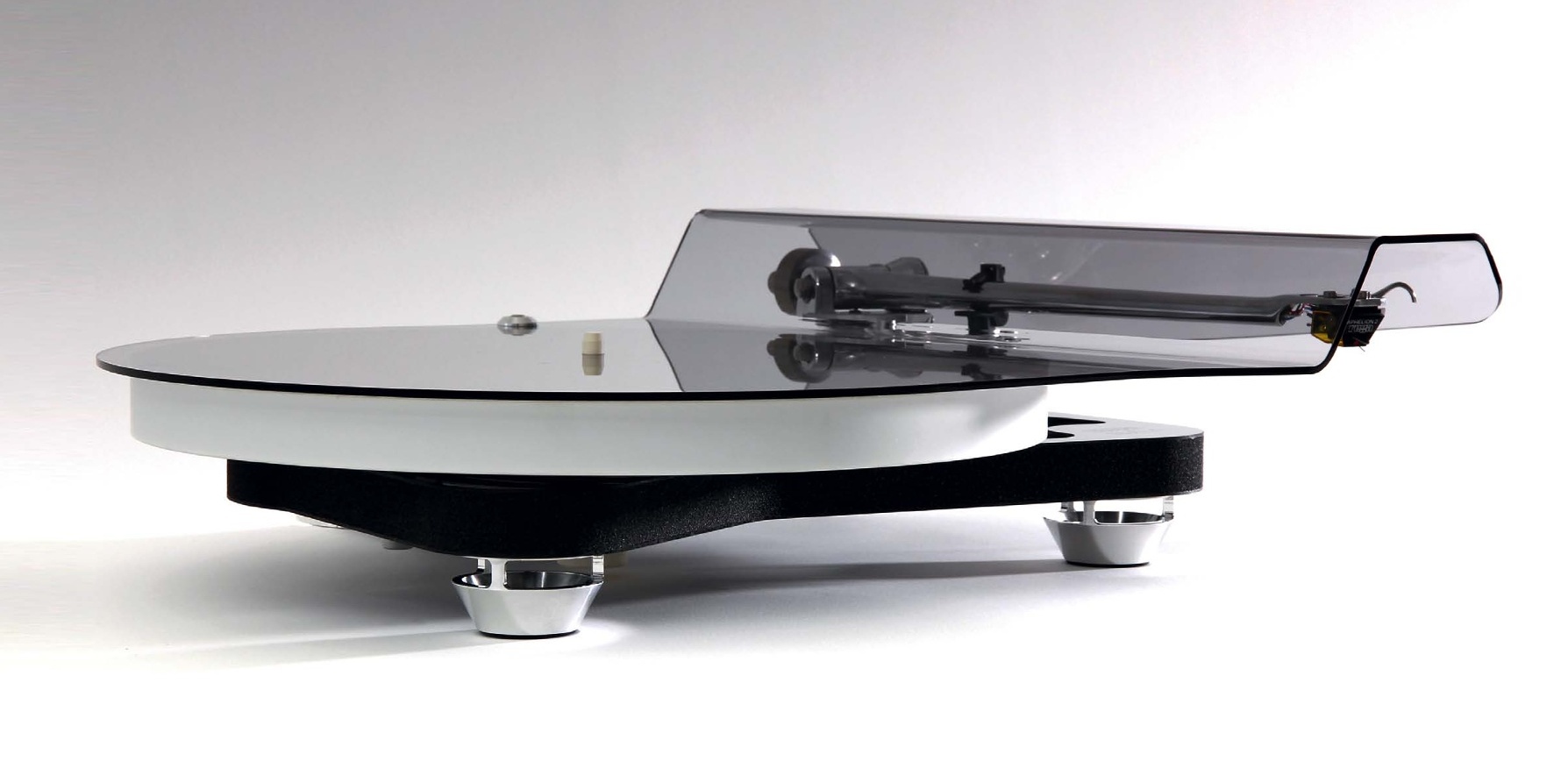
When the author was younger, he felt the need to spread the gospel about analog sound. One sentence that particularly annoyed him went something like this: “Yeah, records are great, they crackle so atmospherically.” Oh my God, no! That was definitely not the point. Nor was it about the quasi-sacred act of placing an LP on the turntable. It was only about music – and just how much of it can be found in a vinyl groove.
Rega Research turntables often proved to be the best affordable “evidence” for HiFi fans with sharp ears. While other turntables wallowed in or seduced with supposed analog sound, which was often nothing more than a unique timbre, Rega’s models played more straightforward and informative.
The higher you climb in Rega’s hierarchy, the less distortion the purist players from Essex County add, as the writer knows from his long experience with models P3, P9, and P10. The downside: some analog fans feel that the minimalist players from Southend-on-Sea, with their clear, dynamic sound, appeal more to the head than to the gut. Furthermore, the more expensive a Rega turntable is, the less material the dealer can hand over to the buyer. So, if you purchase the ultra-purist Naia with the Aphelion-2 MC system for $17,000, you should be aware that this elegant duo is only somewhat suitable for impressing friends who know nothing about high-end analog.
The Naia, like all of Rega’s turntables, breaks with common analog traditions and requires a good deal of experience and love for understatement. However, for those who view their frontend less as an altar and more as a no-compromise engineering product, the Rega Naia/Aphelion combination reveals a bright sun on the vinyl horizon, as we will reveal in this review.
Mass Absorbs Energy
Rega founder Roy Gandy first worked as an engineer at the Ford Motor Company in the early seventies. In his spare time, he built and repaired audio equipment. Among other things, he once made a concrete base to “improve” his first turntable – an eye-opening experience for him, as he concluded that mass is a bad thing because energy transfers more easily from a heavy to a light object than vice versa. That’s why Rega turntables still have relatively heavy platters compared to their lightweight but stiff bases. The idea is that lighter chassis transfer less motor and bearing noise to the platter. With the new Naia, the Englishman has taken this concept to the extreme, as seen in the photo below. In short, Gandy’s turntable philosophy can be summarized as follows: mass absorbs energy – and lost energy means lost music.
The Legend of the Naiad
The development of the Rega Naia dates back to 2009 when the company embarked on a research and development project aimed at pushing its core principles of low mass and high rigidity in turntable design to the limits of possibility. Since cost was no issue, the Rega engineers, according to CEO Phil Freeman, could have “even asked for moon dust.” The result was the legendary Naiad turntable, which was never meant to be sold. But there was a problem: everyone who heard the Naiad wanted one.
After increasing pressure from customers and distributors, Rega decided to produce 50 units in a limited run. However, the production of the Naiad was so complex that only three employees in the company could assemble it. The sale price was $32,000!
The Naia presented here is the production version of the Naiad and, according to the manufacturer, is closer to the “supermodel” than to the much cheaper P10 turntable. We’ll find out how true this is in our listening test. But first, more information on the unusually complex design of the Naia.
From Naiad to Naia
Originally, the Naia was supposed to sit between the Naiad and P10. However, Rega didn’t just facelift the latter, but improved all parameters – as far as current possibilities allowed for the analog specialists and their suppliers from England and Germany! In broad terms, the high-tech materials come from the “masterpiece,” while the basic form is borrowed from the P10.
The skeleton chassis is radically purist, surprisingly lightweight, and consists of a Tancast-8 foam core surrounded on both sides by carbon fibers impregnated with graphene. While the foam layer reduces the transmission of motor vibrations, the two carbon fiber layers are meant to increase the rigidity of the minimal construction. The area between the arm base and the platter bearing is further reinforced by ceramic braces.
According to Rega, the mentioned platter bearing is the most precise and durable ever made for HiFi purposes. Both the bearing and the platter spindle are made from a ceramic composite material called ZTA (Zirconium Toughened Alumina), known for its hardness and resistance to abrasive wear, making it ideal for a turntable of the highest category.
Speaking of ZTA: Rega has been using white platters made of this material for years, appreciating its immense stiffness. For the 2.6-kilogram (5.7 lbs) platter of the Naia, the English engineers even added more mass compared to the P10, which may seem shocking in the context of Rega’s philosophy. But there’s a good reason for this: the Naia’s platter is shaped so that its mass increases towards the edge. With this clever weight distribution, Rega harnesses the flywheel effect for perfect speed stability.
A few words about the tonearm: the shape of the non-adjustable RB Titanium arm is familiar to fans of the brand. The tube and headshell are made from a single piece and are now largely titanium instead of aluminum. The material change and the improved bearing unit are meant to result in an even lighter and stiffer design. To further reduce weight, the English company polishes the ultra-low-friction tonearm, with no consideration for aesthetics.
More Information, More Music
The first listening impression of the Naia was given to the test editor during a press event in November. As nice as the demonstration in a hotel in Aschau in Chiemgau was, it only provided a vague impression of the “super Rega’s” potential. To better explore it, the writer received both the test candidate and the P10 with the Aphelion MC at home. Both Rega turntables played in our listening room through Rega’s new reference phono stage (Aura MC) in a highly resolving, neutral system.
After just a few bars, the editors felt that the Aphelion on the Naia sounded louder. Deviations of, say, 1 dB wouldn’t be unusual for hand-built MCs in small series. But far from it: both cartridges turned out to be virtually identical in level in the test lab. To eliminate any remaining doubts, the testers swapped the systems between the turntables.
And? The impressive sound difference remained! This clarified that the Naia is a sensation, as the P10 is already a “bombshell” in its own right. Yet, the “big one” sounded noticeably more dynamic, lively, and rhythmically engaging. Furthermore, the incredible flood of details extracted from the vinyl groove flowed so organically into each other that the Naia distinguished itself as the even more authentic player, with a sound that, despite Rega’s typical dryness, also had something friendlier and more fluid about it. In contrast, the P10, for all its quality, seemed more effortful, narrower – and, if you will, “rougher.”
“Fantasy” by Earth, Wind & Fire isn’t just a song about the power of dreams and belief in an ideal world, but also a very densely produced track where solo and ensemble vocals, string and percussion layers, and brass instruments constantly interplay. The way the Naia unraveled the layers of this track from an old budget reissue – which, to be honest, is of second-rate quality – left the author breathless. He had never heard this song in such depth. Just like with “Fantasy,” everything with the Naia sounded incredibly clear, informative, clean, and captivating.



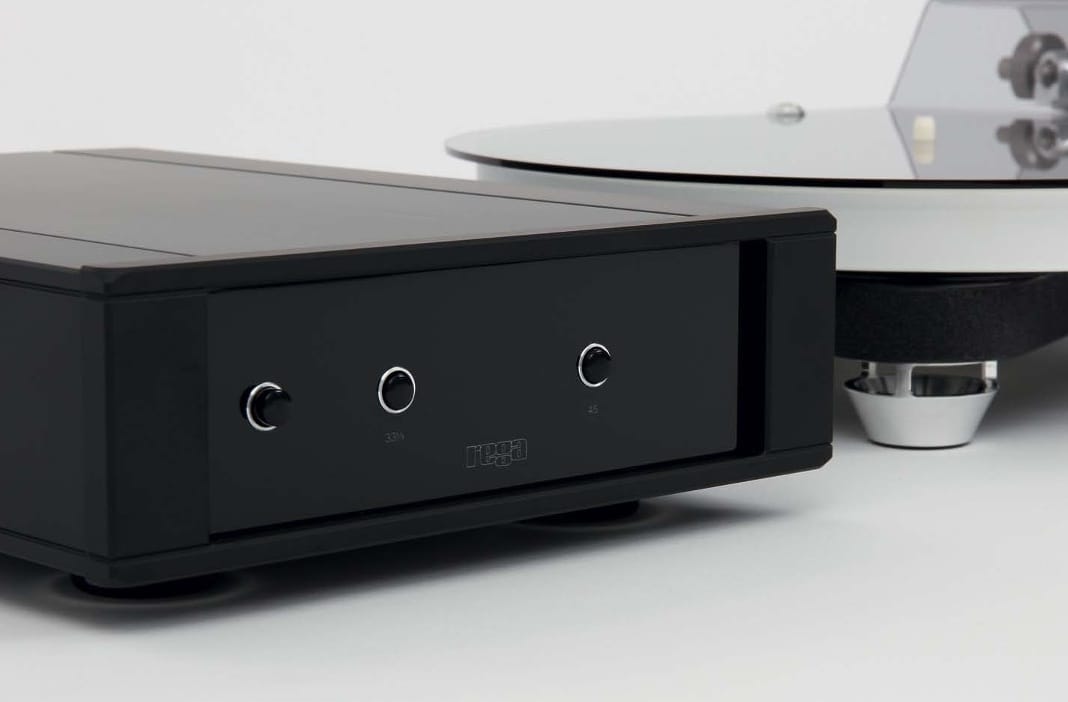
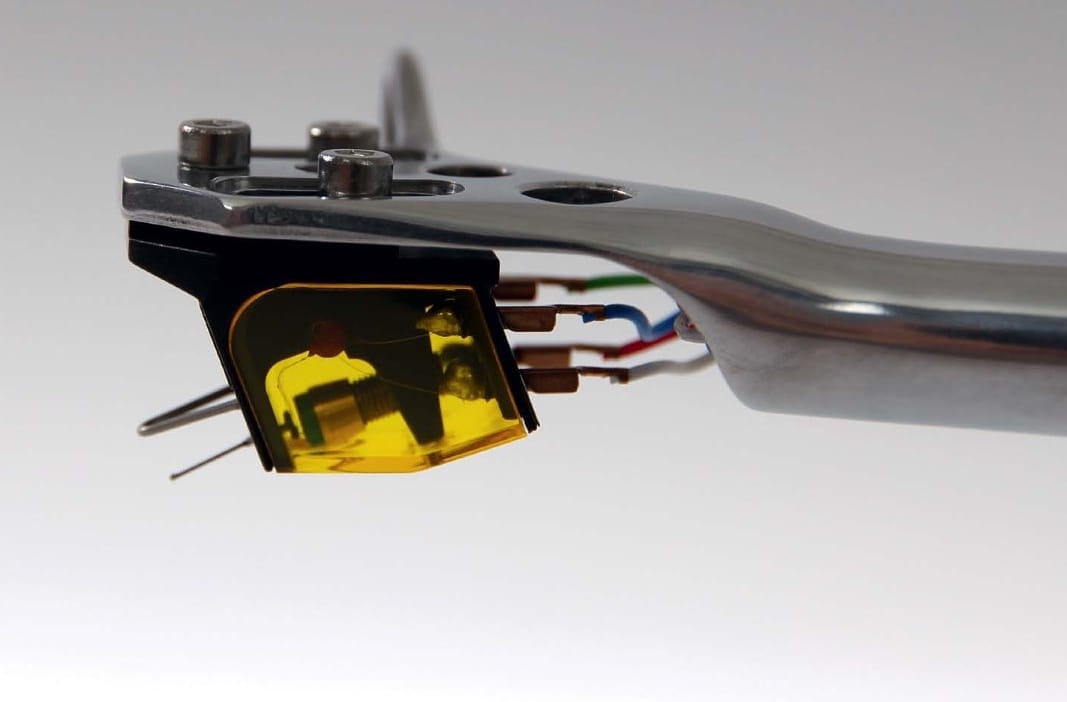
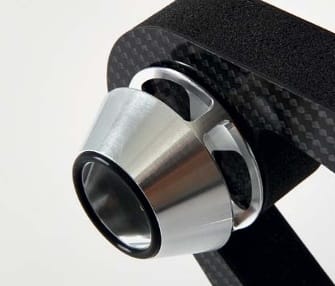
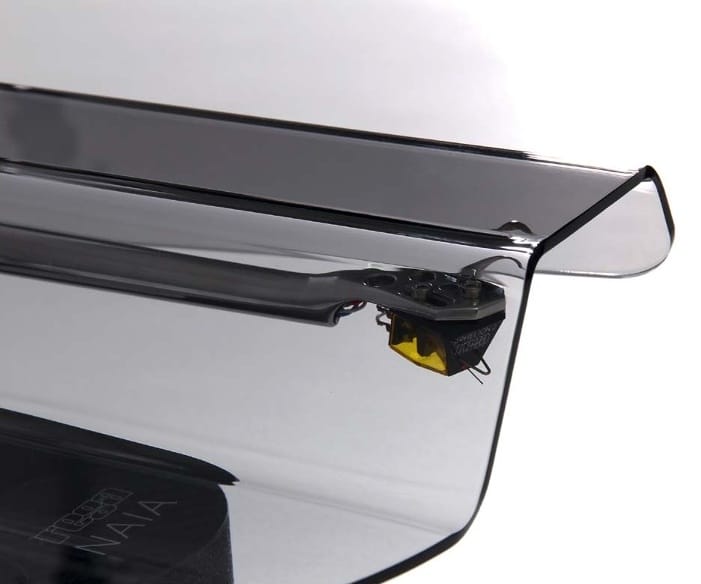


Measured Performance
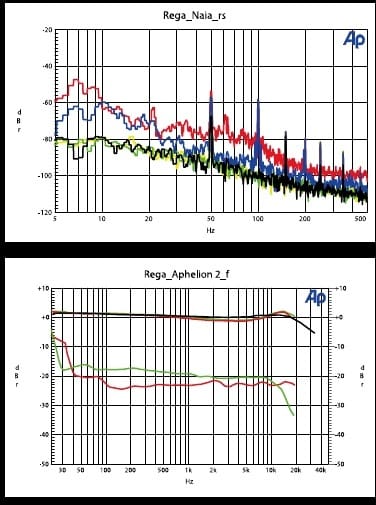
The rumble spectrum shows peaks especially at 50 and 100 Hz, while the higher-frequency hum components barely rise above the self-noise of the test record (red). Other noises do not occur, and the rated rumble figure is a good 71 dB with a record or 73 dB with a coupler. In terms of speed consistency, the Naia shines with an exceptional 0.07% according to strict IEC and 2-sigma standards.
The absolute speed matched at 0.08% right away. The Aphelion 2 showed minimal treble distortion (0.08/0.05% L/R) and good tracking ability (70-90 μm). The frequency response is clean, and the channel separation, which is fairly consistent across frequencies, is a decent 20/24 dB (L/R). Power consumption in standby/operation is 3.0/8.0 W.
Tech Specs
- Model: REGA NAIA / APHELION 2
- List Price: From €12,500 (Test unit: €16,000) (~$13,200 / $16,900)
- Dimensions (W x H x D): 42.0 x 12.5 x 35.0 cm (16.5 x 4.9 x 13.8 in)
- Weight: 4.7 kg (10.4 lbs)
- Drive: Belt drive over sub-platter
- Speeds: 33 & 45 RPM
- Speed control: Electronic
- Adjustable tonearm height: No
- Adjustable feet height: No
- Pitch control: No
- Full automatic/end switch-off: No
- Special features: 3 drive belts
Verdict
According to the manufacturer, the Naia is the best turntable Rega can build. Analog fans should savor this statement like a fine chocolate, because after this test, the editors are convinced that it’s not just marketing hype.
The Naia is one of the best turntables in the world – a high-flyer for the experienced, who can do without ornamentation and always suspected that the most information/music might indeed be hidden in a good old vinyl groove.
Test Results:
- Sound (Cinch/RCA): 9.3/10 (185 points)
- Features: 8/10 (good)
- Operation: 9.5/10 (very good)
- Craftsmanship: 9/10 (excellent)
Audio Benchmark:
- Overall rating: 9.3/10 (185 points)
- Price/Performance: 9.5/10 (very good)



